ASM Metals HandBook Vol. 14 - Forming and Forging
Подождите немного. Документ загружается.

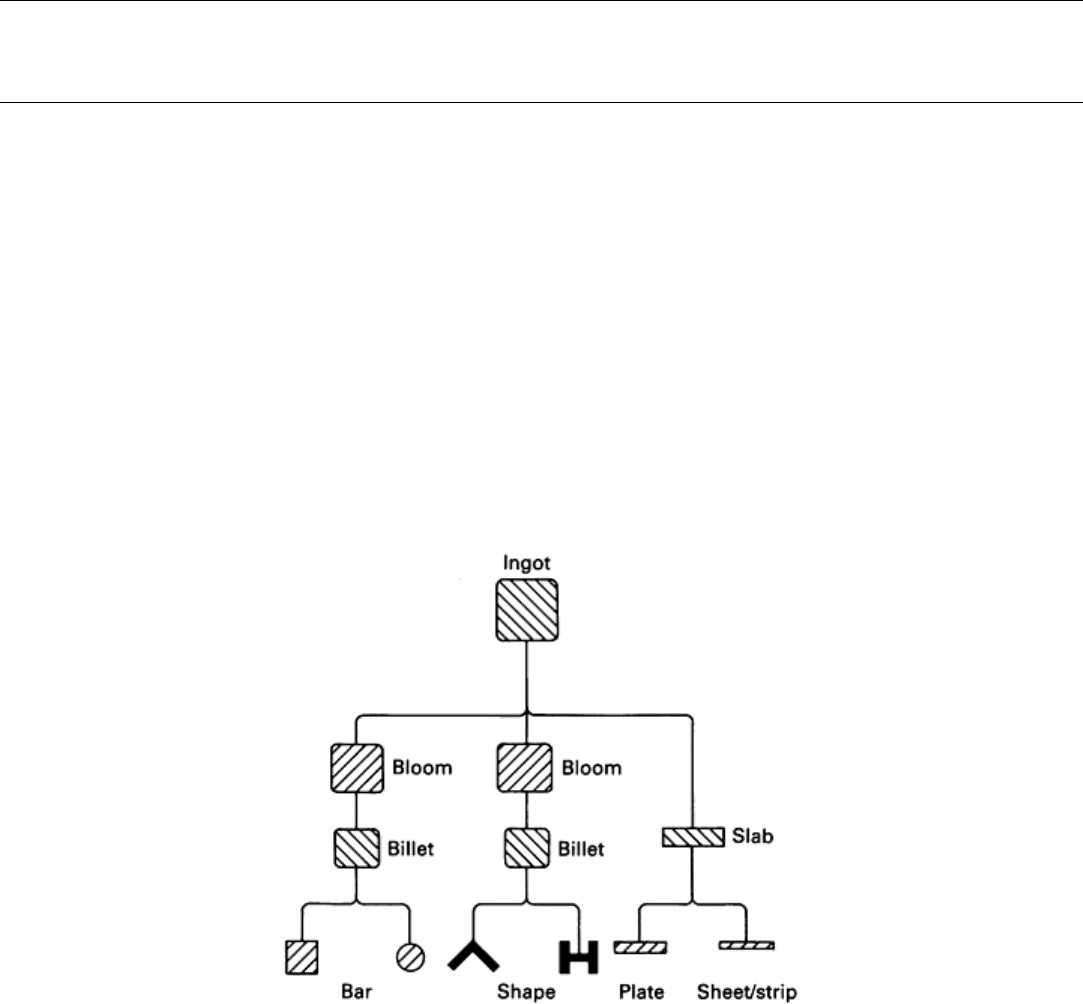
The sections "Basic Rolling Processes," "Strip Rolling Theory," "Mechanics of Plate Rolling," and "Shape Rolling," were
adapted from Rolling of Strip, Plate and Shapes, Chapter 16, in Metal Forming: Fundamentals and Applications, by T.
Altan, S.-I. Oh, and H.L. Gegel, American Society for Metals, 1983, p 249-276.
Flat, Bar, and Shape Rolling
G. D. Lahoti, The Timken Company; S.L. Semiatin, Battelle Columbus Division
Basic Rolling Processes
Many engineering metals, such as aluminum alloys, copper alloys, and steels, are often cast into ingots and are then
further processed by hot rolling into blooms, slabs, and billets, which are subsequently rolled into other products such as
plate, sheet, tube, rod, bar, and structural shapes (Fig. 2). The definitions of these terms are rather loose and are based on
the traditional terminology used in the primary metal industry. For example, a bloom has a nearly square cross section
with an area larger than 205 cm
2
(32 in.
2
); the minimum cross section of a billet is about 38 × 38 mm (1.5 × 1.5 in.), and a
slab is a hot-rolled ingot with a cross-sectional area greater than 103 cm
2
(16 in.
2
) and a section width of at least twice the
section thickness. Plates are generally thicker than 6.4 mm (0.25 in.), whereas sheets are thinner-gage materials with very
large width-to-thickness ratios. Sheet material with a thickness of a few thousandths of an inch is referred to as foil.
Rolling of blooms, slabs, billets, plates, and structural shapes is usually done at temperatures above the recrystallization
temperature, that is, in the hot-forming range, where large reductions in height or thickness are possible with moderate
forming pressures. Sheet and strip often are rolled cold in order to maintain close thickness tolerances.
Fig. 2 Rolling sequence for fabrication of bars, shapes, and flat products from blooms, billets, and slabs
The primary objectives of the rolling process are to reduce the cross section of the incoming material while improving its
properties and to obtain the desired section at the exit from the rolls. The process can be carried out hot, warm, or cold,
depending on the application and the material involved. The technical literature on rolling technology, equipment, and
theory is extensive because of the significance of the process (Ref 1, 2, 3, 4, and 5). Many industrial investigators prefer
to divide rolling into cold and hot rolling processes. From a fundamental point of view, however, it is more appropriate to
classify rolling processes on the bases of the complexity of metal flow during the process and the geometry of the rolled
product. Thus, the rolling of solid sections can be divided into the categories below.

Uniform Reduction in Thickness with No Change in Width. This is the case with strip, sheet, or foil rolling
where the deformation is in plane strain, that is, in the directions of rolling and sheet thickness. This type of metal flow
exists when the width of the deformation zone is at least 20 times the length of that zone.
Uniform Reduction in Thickness with an Increase in Width. This type of deformation occurs in the rolling of
blooms, slabs, and thick plates. The material is elongated in the rolling (longitudinal) direction, is spread in the width
(transverse) direction, and is compressed uniformly in the thickness direction.
Moderately Nonuniform Reduction in Cross Section. In this case, the reduction in the thickness direction is not
uniform. The metal is elongated in the rolling direction, is spread in the width direction, and is reduced nonuniformly in
the thickness direction. Along the width, metal flow occurs only toward the edges of the section. The rolling of an oval
section in rod rolling or of an airfoil section would be considered to be in this category.
Highly Nonuniform Reduction in Cross Section. In this type of deformation, the reduction in the thickness
direction is highly nonuniform. A portion of the rolled section is reduced in thickness while other portions may be
extruded or increased in thickness. As a result, in the width (lateral) direction metal flow may be toward the center. Of
course, in addition, the metal flows in the thickness direction as well as in the rolling (longitudinal) direction.
The above discussion illustrates that, except in strip rolling, metal flow in rolling is in three dimensions (in the thickness,
width and rolling directions). Determinations of metal flow and rolling stresses in shape rolling are very important in
designing rolling mills and in setting up efficient production operations. However, the theoretical prediction of metal flow
in such complex cases is nearly impossible at this time. Numerical techniques are being developed in an attempt to
simulate metal flow in such complex rolling operations.
References cited in this section
1.
G.E. Dieter, chapter 19 in Mechanical Metallurgy, McGraw-Hill, 1961, p 488
2.
E.G. Thomsen, C.T. Yang, and S. Kobayashi, chapter 18 in Mechanics of Plastic Deformat
ion in Metal
Processing, Macmillan, 1965, p 373
3.
A. Geleji, Forge Equipment, Rolling Mills and Accessories, Akademiai Kiado, 1967
4.
G.W. Rowe, chapter 9 in Principles of Industrial Metalworking Processes, Edward Arnold, 1968, p 208
5.
E.C. Larke, The Rolling of Strip, Sheet and Plate, Chapman and Hall, 1957
Flat, Bar, and Shape Rolling
G. D. Lahoti, The Timken Company; S.L. Semiatin, Battelle Columbus Division
Strip Rolling Theory
The most rigorous analysis was performed by Orowan (Ref 6) and has been applied and computerized by various
investigators (Ref 7, 8, 9, 10, 11, 12). More recent studies consider elastic flattening of the rolls and temperature
conditions that exist in rolling (Ref 9, 13). The roll-separating force and the roll torque can be estimated with various
levels of approximations by such mathematical techniques as the slab method, the upper bound method (Ref 10), or the
slip line method of analysis (Ref 2, 4). Most recently, computerized numerical techniques are being used to estimate metal
flow, stresses, roll-separating force, temperatures, and elastic deflection of the rolls (Ref 9, 13).
Simplified Method for Estimating Roll-Separating Force. The strip-rolling process is illustrated in Fig. 3.
Because of volume constancy, the following relations hold:
W · H
0
· V
0
= W · H · V = W · H
1
· V
1
(Eq 1)
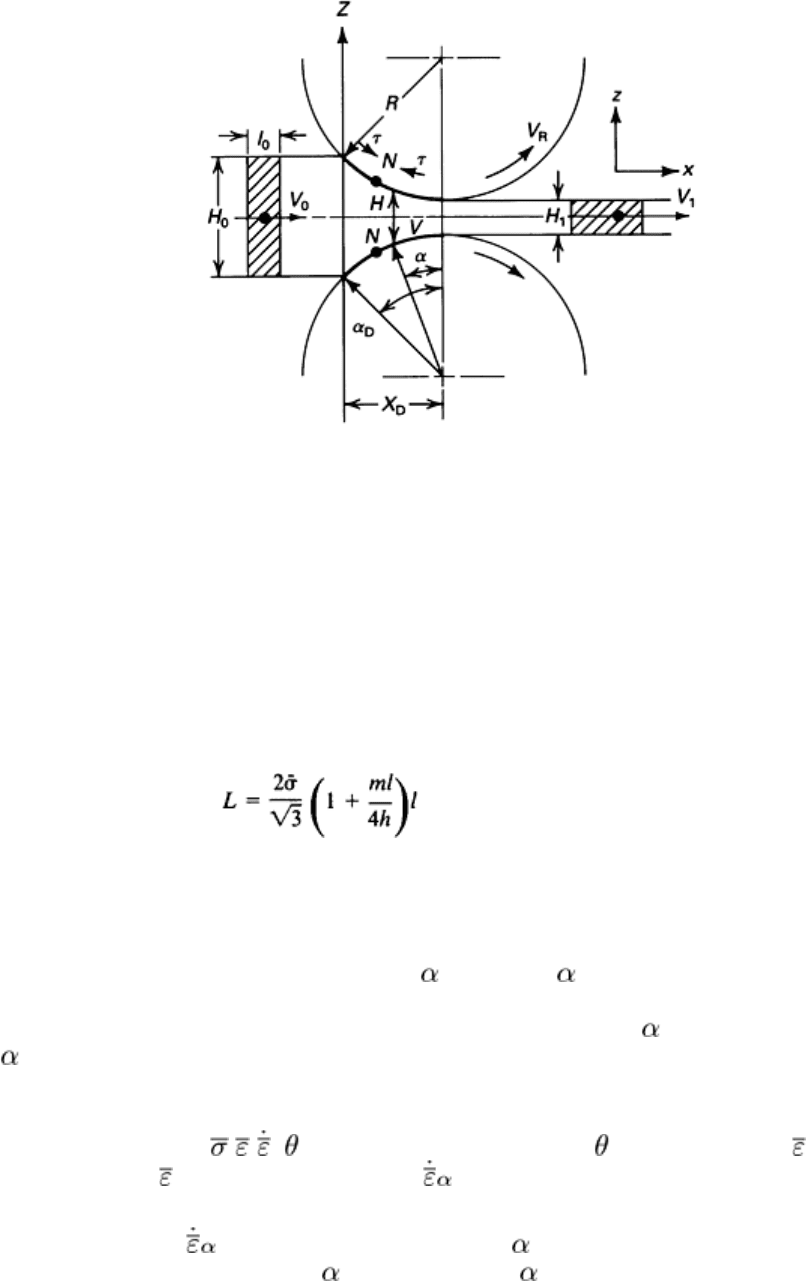
where W is the width of the strip; H
0
, H, and H
1
are the thicknesses at the entrance, in the deformation zone, and at the
exit, respectively; and V
0
, V, and V
1
are the velocities at the entrance, in the deformation zone, and at the exit,
respectively. In order to satisfy Eq 1. the exit velocity V
1
must be larger than the entrance velocity V
0
. Therefore, the
velocity of the deforming material in the x or rolling direction must steadily increase from entrance to exit. At only one
point along the roll-strip interface is the surface velocity of the roll, V
R
, equal to the velocity of the strip. This point is
called the neutral point, or neutral plane, indicated by N in Fig. 3.
Fig. 3 Representation of strip rolling. The strip width w is constant in the y (width) direction.
The interface frictional stresses are directed from the entrance and exit planes toward the neutral plane because the
relative velocity between the roll surface and the strip changes its direction at the neutral plane. This will be considered
later in estimating rolling stresses.
An approximate value for the roll-separating force can be obtained by approximating the deformation zone, shown in Fig.
3, with the homogeneous plane-strain upsetting process. With this assumption, Eq 2 is valid, that is, the load per unit
width of the strip is given by:
(Eq 2)
However, in this case the following approximations must be made:
• Average strip height h = 0.5(H
0
+ H
1
)
• Average length of the deforming strip l = R
D
, with cos
D
= 1 - (H
0
- H
1
)2R.
In the literature, it is
often recommended that the value of the projection of strip length X
D
(Fig. 3) be used for l;
however,
considering the effect of friction on the roll-strip interface length, R
D
, it is more appropriate to use l
=
R
D
To estimate average flow stress ( , ) at a given rolling temperature , the average strain is obtained from the
thickness reduction, that is, = ln (H
0
/H
1
). The strain rate is given by:
= V
z
/H = 2V
R
sin /H
= [2V
R
sin ]/[H
1
+ 2R(1 - cos )]
(Eq 3)
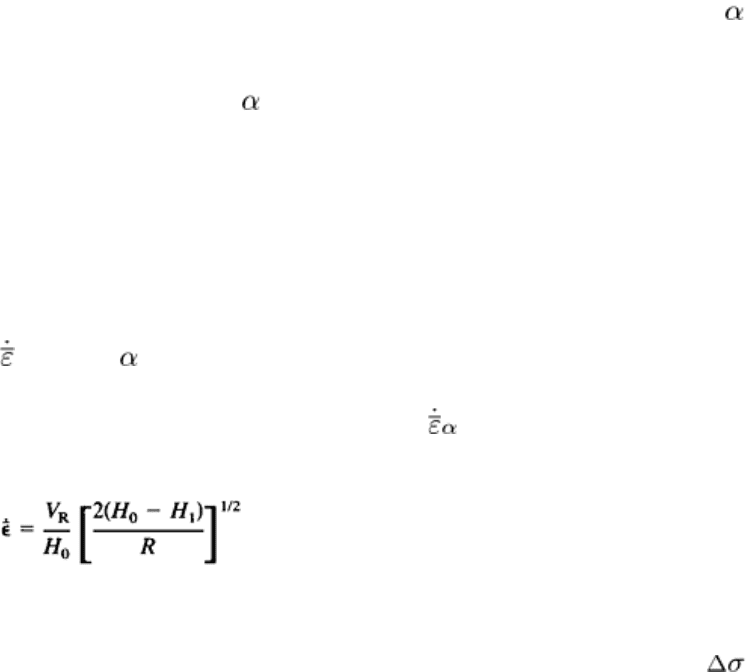
where V
z
is the velocity at a given plane in the z direction (see Fig. 3), H is the thickness at a given plane (roll angle ) in
the deformation zone, and V
R
is the roll surface velocity. At the entrance plane:
V
z
= 2V
R
sin
D
; H = H
0
At the exit plane:
V
z
= 0; H = H
1
By taking a simple average of these two limiting values, an approximate value of strain rate is obtained:
= [2V
R
sin
D
/H
0
+ 0]/2
(Eq 4)
A more accurate value can be obtained by calculating an integrated average of (Eq 3) throughout the deformation
zone. Then, an average approximate value is (Ref 1):
(Eq 5)
The stress (roll pressure) distribution in strip rolling is illustrated in Fig. 4. The maximum stress is at the neutral
plane N. These stresses increase with increasing friction and length of the deformation zone X
D
. Tensile stresses applied to
the strip at entrance or exit have the effect of reducing the maximum stress (by an amount approximately equal to
z
in
Fig. 4b) and shifting the position of the neutral plane. The analogy to plane-strain upsetting is illustrated in Fig. 4(a).
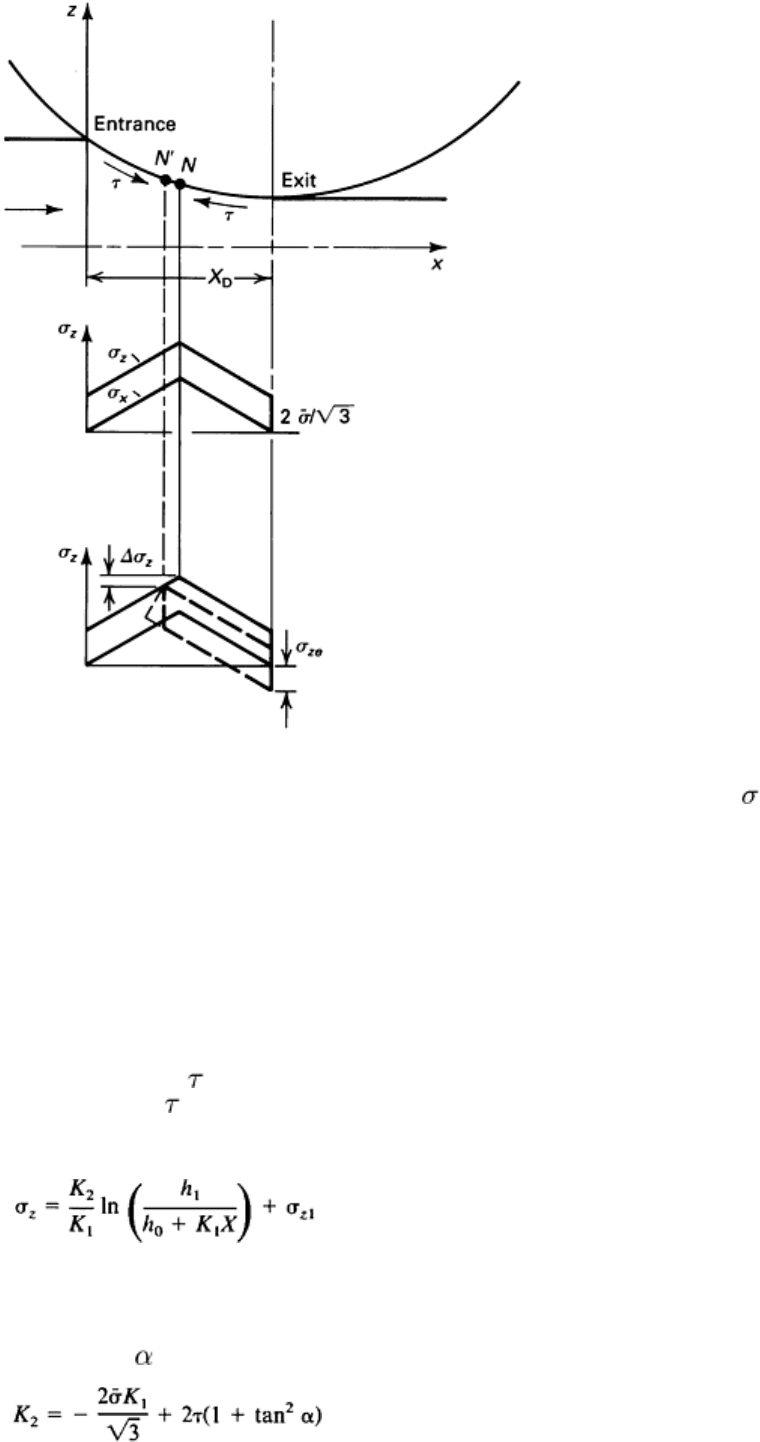
Fig. 4 Stress distribution in rolling. (a) With no tensile stresses at entry or exit. (b) With tensile stress
ze
at
exit.
The stress distribution can be calculated by using the equations derived in most textbooks (Ref 1, 2, 3, 4, 5) or by
following the theory presented by Orowan (Ref 6). However, these calculations are quite complex and require numerical
techniques in order to avoid an excessive number of simplifying assumptions. A computerized solution, with all necessary
details and the listing of the FORTRAN computer program, is also given by Alexander (Ref 8).
For a numerical/computerized calculation of rolling stresses, the deformation zone can be divided into an arbitrary
number of elements with flat, inclined surfaces (Fig. 5). The element, illustrated in this figure, is located between the
neutral and exit planes because the frictional stress is acting against the direction of metal flow. When this element is
located between the entrance and neutral planes, acts in the direction of metal flow. The stress distribution within this
element can be obtained by use of the slab method, as applied to plane-strain upsetting (Ref 14):
(Eq 6)
where
K
1
= -2 tan
(Eq 7)
(Eq 8)

= m /
(Eq 9)
Following Fig. 5, for x = x, h
0
+ K
1
x = h
1
, and therefore Eq 6 gives
z
=
z1
, the boundary condition at x = x, which
is known. For x = 0:
Fig. 5 Stresses in a deformation element used in computerized calculation of rolling stresses
If the element shown in Fig. 5 is located between the entrance and neutral planes, then the sign for the frictional shear
stress must be reversed. Thus, Eq 6 and 7 are still valid, but:
(Eq 10)
In this case, the value of the boundary condition at x = 0, that is,
z0
, is known, and
z1
, can be determined from Eq 6:
(Eq 11)

The stress boundary conditions at exit and entrance are known. Thus, to calculate the complete stress (roll pressure)
distribution and to determine the location of the neutral plane, the length of the deformation zone X
D
(see Fig. 3 and 4) is
divided into n deformation elements (Fig. 6). Each element is approximated by flat top and bottom surfaces (Fig. 5).
Starting from both ends of the deformation zone, that is, entrance and exit planes, the stresses are calculated for each
element successively from one element to the next. The calculations are carried out simultaneously for both sides of the
neutral plane. The location of the neutral plane is the location at which the stresses, calculated progressively from both
exit and entrance sides, are equal. This procedure has been computerized and extensively used in cold and hot rolling of
sheet, plane-strain forging of turbine blades (Ref 15) and in rolling of plates and airfoil shapes (Ref 16, 17).
Fig. 6 Calculation of stress d
istribution by dividing the deformation zone into a number of tapered elements. In
this case, tensile stresses in the strip are zero at both entrance and exit.
Roll-Separating Force and Torque. The integration of the stress distribution over the length of the deformation
zone gives the total roll-separating force per unit width in strip rolling. In addition, the total torque is given by:
(Eq 12)
where X
D
is the length of the deformation zone (Fig. 6), R is roll radius, and F is the tangential force acting on the roll.
Assuming that all energy is transmitted from the roll to the workpiece by frictional force:
dF = dS
(Eq 13)
In Fig. 5, it can be seen that:
dS = dx/cos = dx
(Eq 14)
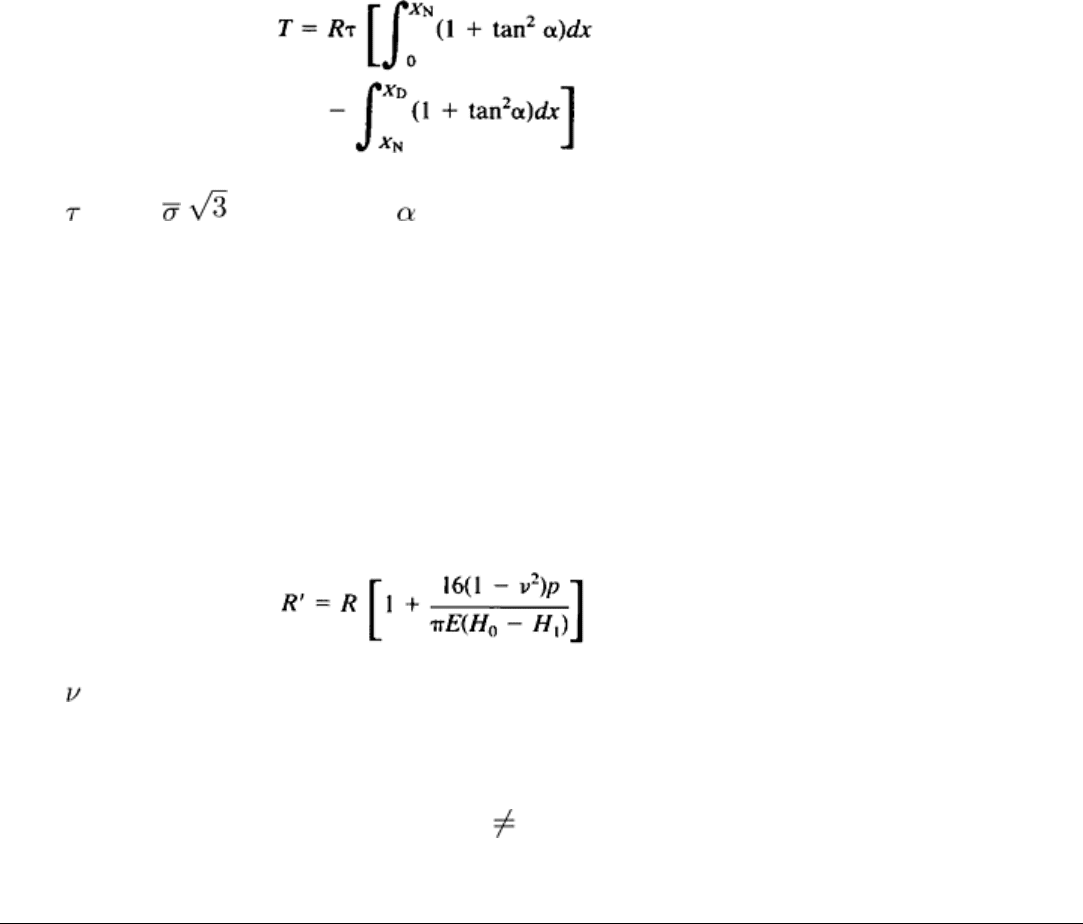
In the deformation zone, the frictional force is in the rolling direction between entry and neutral planes. It changes
direction between the neutral and exit planes. Thus, the total roll torque per unit width is:
(Eq 15)
where equals m / ; R is roll radius; is roll angle (Fig. 3); X
N
is the x distance of the neutral plane from the
entrance (Fig. 6); and X
D
is the length of the deformation zone (Fig. 6).
Elastic Deflection of Rolls. During rolling of strip, especially at room temperature, a considerable amount of roll
deflection and flattening may take place. In the width direction, the rolls are bent between the roll bearings, and a certain
amount of crowning, or thickening of the strip, occurs at the center. This can be corrected by either grinding the rolls to a
larger diameter at the center or by using backup rolls.
In the thickness direction, roll flattening causes the roll radius to "enlarge," increasing the contact length. There are
several numerical methods for calculating the elastic deformation of the rolls (Ref 9). A method for approximate
correction of the force and torque calculations for roll flattening entails replacement of the original roll radius R with a
larger value R'. A value of R' is suggested by Hitchcock (Ref 18) and is referred to extensively in the literature (Ref 2, 4).
This is given as:
(Eq 16)
where is Poisson's ratio of the roll material, p is the average roll pressure, and E is the elastic modulus of the roll
material.
It is obvious that R' and p influence each other. Therefore, a computerized iteration procedure is necessary for
consideration of roll flattening in calculating rolling force or pressure. Thus, the value of p is calculated for the nominal
roll radius R. Then R' is calculated from Eq 16. If R'/R 1, the calculation of p is repeated with the new R' value, and so
on, until R'/R has approximately the value of 1.
References cited in this section
1. G.E. Dieter, chapter 19 in Mechanical Metallurgy, McGraw-Hill, 1961, p 488
2. E.G. Thomsen, C.T. Yang, and S. Kobayashi, chapter 18 in Mechanics of Plastic
Deformation in Metal
Processing, Macmillan, 1965, p 373
3. A. Geleji, Forge Equipment, Rolling Mills and Accessories, Akademiai Kiado, 1967
4. G.W. Rowe, chapter 9 in Principles of Industrial Metalworking Processes, Edward Arnold, 1968, p 208
5. E.C. Larke, The Rolling of Strip, Sheet and Plate, Chapman and Hall, 1957
6. E. Orowan, The Calculation of Roll Pressure in Hot and Cold Flat Rolling, in
Proceedings of the Institute of
Mechanical Engineers, Vol 150, 1943, p 140
7. J.T. Hockett, Calculation of Rolling Forces Using the Orowan Theory, Trans. ASM, Vol 52, 1960, p 675
8. J.M. Alexander, On the Theory of Rolling, in Proceedings of the Royal Society London,
Series A, Vol 326,
1972, p 535
9. G.D. Lahoti, S.N. Shah, and T. Altan, Computer Aided Analy
sis of the Deformations and Temperatures in
Strip Rolling, J. Eng. Ind. (Trans. ASME), Vol 100, May 1978, p 159

10.
B. Avitzur, An Upper-Bound Approach to Cold Strip Rolling, J. Eng. Ind. (Trans. ASME), Feb 1964, p 31
11.
R.B. Sims, The Calculation of Roll Force and Torque in Hot Rolling Mills, in
Proceedings of the Institute of
Mechanical Engineers, Vol 168, 1954, p 191
12.
H. Ford and J.M. Alexander, Simplified Hot-Rolling Calculations, J. Inst. Met., Vol 92, 1963-1964, p 397
13.
D.J. McPherson, Contributions to the Theory and Practice of Cold Rolling, Metall. Trans.,
Vol 5, Dec 1974,
p 2479
14.
T. Altan and R.J. Fiorentino, Prediction of Loads and Stresses in Closed-Die Forging, J. Eng. Ind.
(Trans.
ASME), May 1971, p 477
15.
N. Akgerman and T. Altan, Application of CAD/CAM in Forging Turbine and Compressor Blades,
J. Eng.
Power (Trans. ASME), Series A, Vol 98 (No. 2), April 1976, p 290
16.
G.D. Lahoti, et al., Computer Aided Analysis of Metal Flow and Stresses in Plate Rolling, J. Mech.
Work.
Technol., Vol 4, 1980, p 105
17.
N. Akgerman, G.D. Lahoti, and T. Altan, Computer Aided Roll Pass Design in Rolling of Airfoil Shapes,
J.
Appl. Metalwork., Vol 1, 1980, p 30
18.
J.H. Hitchcock, "Roll Neck Bearings," Research Committee Report, American Society
of Mechanical
Engineers, 1935, cited in The Rolling of Metals,
by L.R. Underwood, Vol I, John Wiley and Sons, 1950, p
15-16
Flat, Bar, and Shape Rolling
G. D. Lahoti, The Timken Company; S.L. Semiatin, Battelle Columbus Division
Mechanics of Plate Rolling
In rolling of thick plates, metal flow occurs in three dimensions. The rolled material is elongated in the rolling direction as
well as spread in the lateral or width direction. Spread in rolling is usually defined as the increase in width of a plate or
slab expressed as a percentage of its original width. The spread increases with increasing reduction and interface friction,
decreasing plate width-to-thickness ratio, and increasing roll-diameter-to-plate thickness ratio. In addition, the free edges
tend to bulge with increasing reduction and interface friction. The three-dimensional metal flow that occurs in plate
rolling is difficult to analyze. Therefore, most studies of this process have been experimental in nature, and several
empirical formulas have been established for estimating spread (Ref 19, 20, 21). Recently, attempts were also made to
predict elongation or spread theoretically (Ref 22, 23, 24). Once the spread has been estimated, the elongation can be
determined from the volume constancy, or vice versa.
An Empirical Method for Estimating Spread. Among the various formulas available for predicting spread,
Wusatowski's formula (Ref 20) is used most extensively and is given as:
W
1
/W
0
= abcd(H
0
/H
1
)
P
(Eq 17)
where W
1
and W
0
are the final and initial widths of the plate, respectively; H
1
and H
0
are the final and initial thicknesses
of the plate, respectively; P equals 10
(-1.269)
(W
0
/H
0
)(H
0
/D)
0.556
; D is the effective roll diameter; and a, b, c, and d are
constants that allow for variations in steel composition, rolling temperature, rolling speed and roll material, respectively.
These constants vary slightly from unity, and their values can be obtained from the literature (Ref 16, 20, 24).
An empirical formula for predicting spread such as Eq 17 gives reasonable results within the range of conditions for the
experiments from which the formula was developed. There is no formula that will make accurate predictions for all the
conditions that exist in rolling. Thus, it is often necessary to attempt to estimate spread or elongation by theoretical
means.
The theoretical prediction of spread involves a rather complex analysis and requires the use of computerized
techniques (Ref 16, 22, 23). A modular upper-bound method has been used to predict metal flow, spread, elongation and
roll torque (Ref 16). The principles of this method are described below. Figure 7 illustrates the coordinate system, the
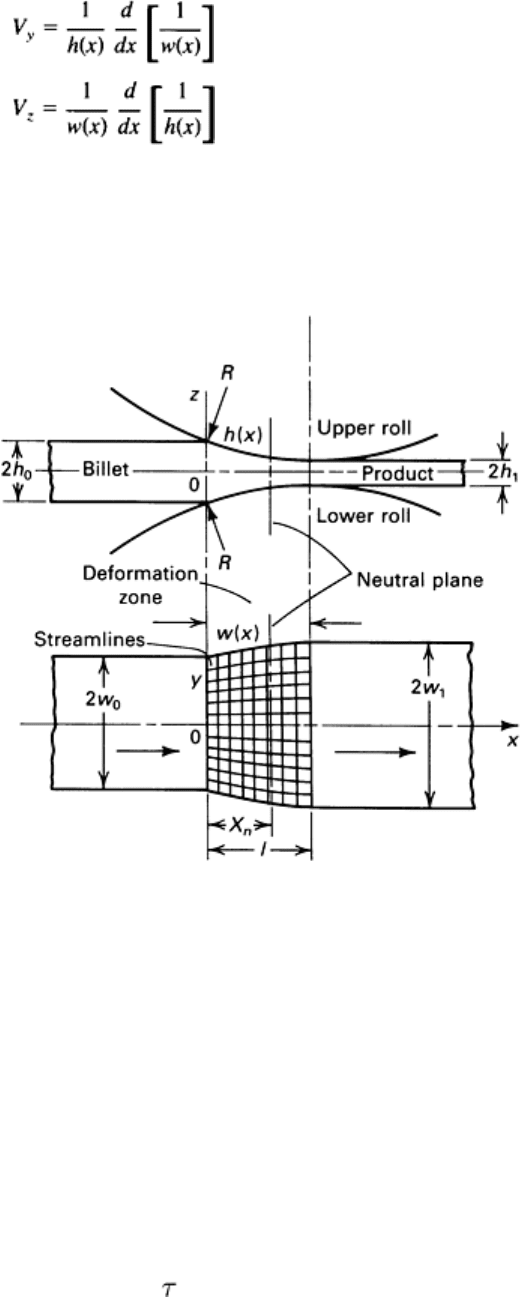
division of the deformation zone into elements, and the notations used. The spread profile is defined in terms of a third-
order polynomial w(x) with two unknown coefficients a
1
and a
2
. The location of the neutral plane x
n
is another unknown
quantity. The following kinematically admissible velocity field, initially suggested by Hill (Ref 25), is used:
V
x
= 1/[w(x)h(x)]
(Eq 18)
(Eq 19)
(Eq 20)
Using Eq 18, 19, and 20, the upper-bound method can be applied to predict spread. A computer program, SHPROL, can
be used for some steps in the analysis. More information on SHPROL is available in the section "Shape Rolling" in this
article.
Fig. 7 Configuration of de
formation and the grid system used in the analysis of the rolling of thick plates.
Source: Ref 16
Prediction of Stresses and Roll-Separating Force. Once the spread (the boundaries of the deformation zone) has
been calculated, this information can be used to predict the stresses and the roll-separating force. The computerized
procedure used here is in principle the same as the method discussed earlier for predicting the stresses in strip rolling (Ref
16).
The deformation zone under the rolls is divided into trapezoidal slabs by planes normal to the rolling direction and along
the stream tubes, as illustrated in Fig. 5 and 8. The stresses acting on strips in the rolling and transverse directions are
illustrated in Fig. 8(b) and 8(c), respectively. As expected from the slab analysis, the stress distributions are very similar
to those illustrated for strip rolling in Fig. 4, 5, and 6. By use of a numerical approach similar to that discussed for strip
rolling, detailed predictions of stresses, in both the longitudinal and lateral directions, can be made. The stresses are
calculated by assuming the frictional shear stress to be constant, as in the case of upper-bound analysis. Thus, the stress
distribution at various planes along the width, or y, direction (Fig. 8) is linear on both sides of the plane of symmetry. The
stress distribution in the rolling, or x, direction is calculated along the streamlines of metal flow (Fig. 7). At each node of
